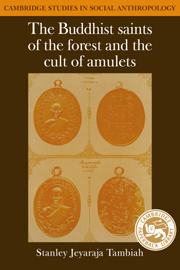Book contents
- Frontmatter
- Contents
- Acknowledgments
- Note on transcription
- 1 Introduction and manifesto
- Part I The arahant and the Path of Meditation
- Part II The hagiography of a Buddhist saint: text and context; the politics of sectarianism
- 6 The biography of a modern saint
- 7 The Buddha's life as paradigm
- 8 The ordering principles behind Buddhist saintly biography
- 9 The disciples of the Master
- 10 The biographer as exemplary forest-monk, meditator, and teacher
- 11 Sectarianism and the sponsorship of meditation
- 12 The Mahānikāi sect's propagation of lay meditation
- 13 The center–periphery dialectic: the Mahāthāt and Bovonniwet sponsorship of meditation compared
- Part III The cult of amulets: the objectification and transmission of charisma
- Part IV Conceptual and theoretical clarifications
- Notes
- Index
- CAMBRIDGE STUDIES IN SOCIAL ANTHROPOLOGY
7 - The Buddha's life as paradigm
Published online by Cambridge University Press: 10 December 2009
- Frontmatter
- Contents
- Acknowledgments
- Note on transcription
- 1 Introduction and manifesto
- Part I The arahant and the Path of Meditation
- Part II The hagiography of a Buddhist saint: text and context; the politics of sectarianism
- 6 The biography of a modern saint
- 7 The Buddha's life as paradigm
- 8 The ordering principles behind Buddhist saintly biography
- 9 The disciples of the Master
- 10 The biographer as exemplary forest-monk, meditator, and teacher
- 11 Sectarianism and the sponsorship of meditation
- 12 The Mahānikāi sect's propagation of lay meditation
- 13 The center–periphery dialectic: the Mahāthāt and Bovonniwet sponsorship of meditation compared
- Part III The cult of amulets: the objectification and transmission of charisma
- Part IV Conceptual and theoretical clarifications
- Notes
- Index
- CAMBRIDGE STUDIES IN SOCIAL ANTHROPOLOGY
Summary
Recent biographies of monks
Before we attempt a detailed interpretation of the biography of Acharn Mun, we should explore what sort of tradition of writing biographies of monks exists in Sri Lanka, Burma, and Thailand. This inquiry is called for because our biographer Maha Boowa himself states in his preface that “the method of presentation here follows that of the ancient compilers who recorded the biographies of some Noble disciples in various texts in the hope that they may be encouraging examples for posterity”. In Sri Lanka and Thailand, as in Burma, there are numerous popular biographies of the Buddha and famous arahants. Many of these stories of arahants are adaptations of old stories transferred to new subjects. But the biographies are not necessarily confined to these heroic figures alone.
That a lively tradition of composing biographies of monks developed in Sri Lanka, primarily in the nineteenth and twentieth centuries, is attested by Malalgoda's study, which uses to advantage this genre of local Siṅhala literature. Malalgoda cites at least ten sources that carry the word caritaya (or caritam or cariyava) in their titles: Of these, one is an edited reprint of an eighteenth-century work, five were published between 1901 and 1913, and the rest later. Furthermore, biographical information on monks is also available in Siṅhala publications that describe the genealogy and history of the various sects and fraternities that developed in Sri Lanka in the nineteenth century. An interesting addition to this list is a biography of a monk called Miripanna Dhammaratana, a famous Siṅhala poet, published in 1868 in English..
Although some of these biographies were about forest-monks, most of Malalgoda's biographies are concerned with famous reformist or activist monks during the years 1700–1900.
- Type
- Chapter
- Information
- The Buddhist Saints of the Forest and the Cult of Amulets , pp. 111 - 123Publisher: Cambridge University PressPrint publication year: 1984



